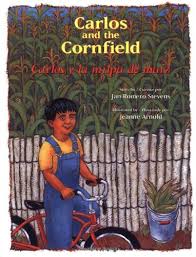
Carlos and the Cornfield / Carlos y la milpa de maiz
Written by Jan Romero Stevens
Illustrated by Jeanne Arnold
Rising Moon, 1995. 32 pp
ISBN: 9780873587358
A young boy named Carlos learns to appreciate hard work after not listening to his father’s advice on how to properly plant sweet yellow corn. Jan Romero Stevens’ story takes place in New Mexico and begins with Carlos admiring a red pocketknife he hopes to buy from Señor Lopez’s store. Without enough money to purchase the knife, Carlos pedals home on his bicycle to help his father in the field. When his father offers to pay him five dollars for planting a large bucket of corn seed, Carlos feels excitement and eagerness to start the job. He knows that with those five dollars he is going to be able to afford buying the red pocketknife.
After many hours pass while working in the field, Carlos worries that he will never finish his job because of the countless rows in the field. In order to finish more quickly, he decides to put six seeds in each hole disregarding his father’s instructions of putting only three seeds per hole. After a while, Carlos pours entire handfuls of seeds in each hole for the last few rows of the field to finish even faster. Once Carlos finishes, he quickly runs to his father to get the money promised to him and rushes to Señor Lopez’s store to buy his red pocketknife.
Months later, the corn starts growing and Carlos is disappointed in seeing that his job was not done right. The sweet yellow corns of the last few rows are not growing properly. Reluctantly, he makes the decision to sell his red pocketknife back to Señor Lopez so he can buy a new bag of corn seed. With this bag of corn, Carlos replants the last several rows of corn properly overnight. Waking up one morning, Carlos receives blue corn cakes for breakfast from his mother. Surprised about the blue corn cakes instead of yellow, his father tells him he planted blue corn seeds rather than yellow the second time. Embarrassed, he reminds his father about what he had told him before planting the corn seeds. His father stated, “Cosechas lo que siembras-you reap what you sow” (Stevens, 1995). With that, Carlos understood the importance of working hard and listening to his father’s instructions.
This book is appropriate for children between grades K-3. The translations are accurate and consistent throughout the text and the story emphasizes the cultural values of Mexican Americans. A related text to this tale is Carlos and the Squash Plant/ Carlos y la Planta de Calabaza (1993) that also depicts the diverse lifestyle of Mexican American culture. The author sends a clear message to young children that listening to instructions is important. This is an excellent book for possibilities of discussion as children talk about cases where they did not listen to their parents and the consequences. This simple yet engaging story shows how children can learn through valuable lessons about listening.
The author, Jan Romero Santos, enjoys the Latino culture through writing children’s books and learning the Spanish language with her two children, Jacob and Paul. Jan grew up in New Mexico and Arizona and also writes for newspapers and magazines as well as children’s books. Jeanne Arnold’s illustrations portray the Española Valley in northern New Mexico. She was inspired by Mexican painters such as Diego Rivera to illustrate this book. Through these texts and illustrations, the cultural authenticity of the book depicts accurate daily experiences of Mexican American culture and history of the Southwest. The drawings are large and clear so all students in the classroom are able to see them when the book is read aloud.
Cindy Amador, Texas Woman’s University, Denton, TX
WOW Review, Volume VIII, Issue 4 by Worlds of Words is licensed under a Creative Commons Attribution-NonCommercial-ShareAlike 4.0 International License. Based on work at https://wowlit.org/on-line-publications/review/viii-4/
